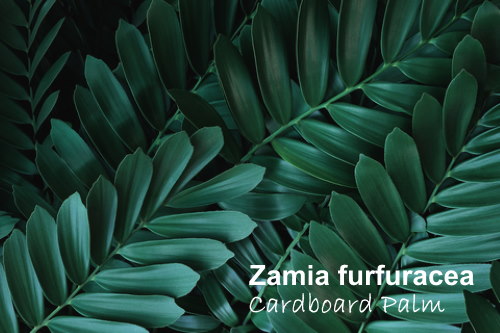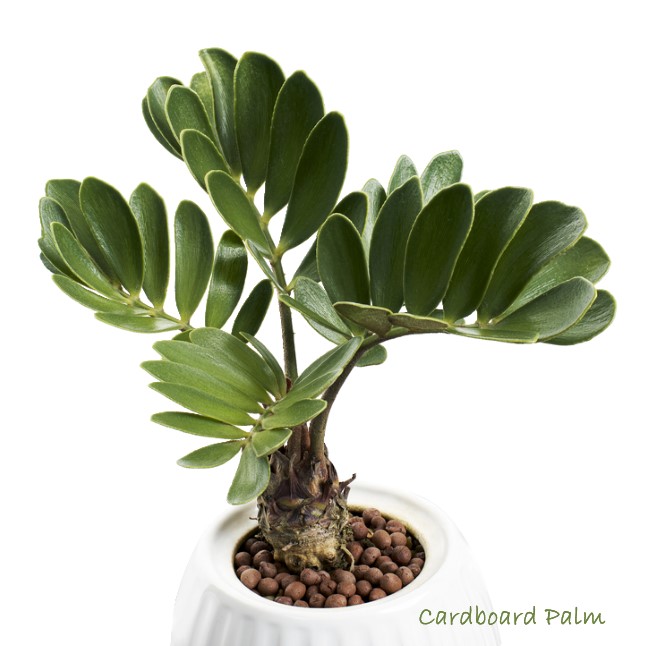Cardboard Palm Care
Cardboard Palm only looks like a palm. Known botanically as Zamia furfuracea, it's a Cycad native to Mexico and is much easier to please indoors than a real palm because of its tolerance of dry air.
Place it in a sunny spot, and you'll find it needs little attention to thrive. In this guide, you'll discover how to grow this eye-catching plant indoors, including how often to water, when to repot, and how to prevent leaf drop.
 Lush, evergreen leaves of the Cardboard Palm plant. Photo ©Chansom Pantip
Lush, evergreen leaves of the Cardboard Palm plant. Photo ©Chansom PantipGet to Know Cardboard Palm
Cardboard Palm is an evergreen, shrub-like plant with origins in Eastern Mexico. How big does it get? Although slow-growing, Zamia furfuracea can grow up to 6 ft (1.8 m) indoors.
It's a semi-succulent that holds water in its thick trunk, so it won't mind if you occasionally forget to water. Don't allow the soil to get too dry, though, or this plant may drop its leaves.
Cardboard Palm is about as low-maintenance as you could hope for. You'll never need to prune, because it grows in a rosette from the trunk, creating a full, leafy plant -- from the base to the top. The stems can grow 2 to 4 feet long and are covered with thick, fuzzy leaflets that feel dry and papery like cardboard.
Male or female cone-like structures will form on separate Zamia furfuracea plants. Don't bother collecting the seeds because they're not viable. (See "Propagation" below.)
Repot in spring when the plant becomes root-bound. Use a heavy container to prevent toppling, because mature plants can get top-heavy. Older plants can be top-dressed instead by replacing the top 2-3 in (5-7.5 cm) of soil with fresh soil.
CAUTION TO PET OWNERS: Unfortunately, the seeds of this beautiful plant are extremely poisonous. Keep the plant away from children and pets. I've read several sad accounts from dog owners who lost their pets after eating the seeds from this plant.
 Easy-to-grow Cardboard Palm makes a handsome houseplant. Photo © Dewins
Easy-to-grow Cardboard Palm makes a handsome houseplant. Photo © DewinsCardboard Palm Care
Light: Bright light to full sun. Turn the plant regularly in front of the window so that it will grow evenly. Otherwise, the stems will grow toward the sunlight, creating a lop-sided plant.
Water: Water thoroughly then allow top 2 in (5 cm) to dry out before watering again. Put it in a pot with drainage holes to prevent soggy soil. Cardboard palm grows the most spring through fall, so cut back on water in the winter months. Avoid getting water on the base of the plant or the foliage, which can cause this semi-succulent to rot. Water the potting mix only.
Humidity: Average room (around 40% relative humidity) or drier
Temperature: Average room temperature 65-75°F/18-24°C year-round. It's cold-hardy down to 25°F/-1°C, but prefers to be warm.
Soil: Equal parts good-quality potting mix and sand for good drainage.
Fertilizer: Feed once in spring and again in summer with a time-release fertilizer.
Propagation: Buy good-quality seeds. Any seeds collected from a mature plant are not fertile unless they are cross-pollinated. Use a seedling heat mat to maintain an even 70°F/21°C. Seeds are slow to germinate and seedlings are slow-growing. Be patient, it'll take years for them to grow tall. Cardboard Palm seeds are poisonous and can be lethal to pets.


